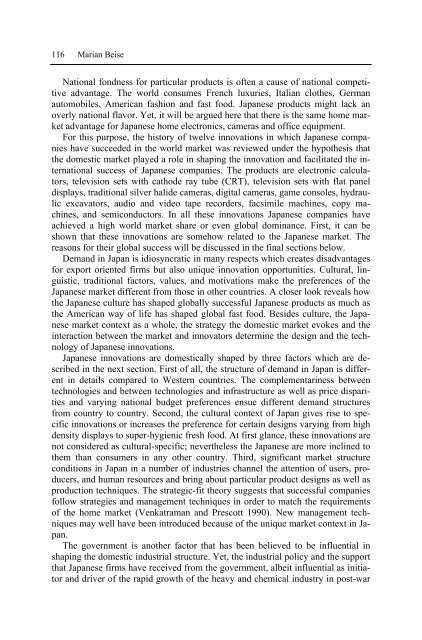Management of Technology and Innovation in Japan
Management of Technology and Innovation in Japan
Management of Technology and Innovation in Japan
Create successful ePaper yourself
Turn your PDF publications into a flip-book with our unique Google optimized e-Paper software.
116 Marian Beise<br />
National fondness for particular products is <strong>of</strong>ten a cause <strong>of</strong> national competitive<br />
advantage. The world consumes French luxuries, Italian clothes, German<br />
automobiles, American fashion <strong>and</strong> fast food. <strong>Japan</strong>ese products might lack an<br />
overly national flavor. Yet, it will be argued here that there is the same home market<br />
advantage for <strong>Japan</strong>ese home electronics, cameras <strong>and</strong> <strong>of</strong>fice equipment.<br />
For this purpose, the history <strong>of</strong> twelve <strong>in</strong>novations <strong>in</strong> which <strong>Japan</strong>ese companies<br />
have succeeded <strong>in</strong> the world market was reviewed under the hypothesis that<br />
the domestic market played a role <strong>in</strong> shap<strong>in</strong>g the <strong>in</strong>novation <strong>and</strong> facilitated the <strong>in</strong>ternational<br />
success <strong>of</strong> <strong>Japan</strong>ese companies. The products are electronic calculators,<br />
television sets with cathode ray tube (CRT), television sets with flat panel<br />
displays, traditional silver halide cameras, digital cameras, game consoles, hydraulic<br />
excavators, audio <strong>and</strong> video tape recorders, facsimile mach<strong>in</strong>es, copy mach<strong>in</strong>es,<br />
<strong>and</strong> semiconductors. In all these <strong>in</strong>novations <strong>Japan</strong>ese companies have<br />
achieved a high world market share or even global dom<strong>in</strong>ance. First, it can be<br />
shown that these <strong>in</strong>novations are somehow related to the <strong>Japan</strong>ese market. The<br />
reasons for their global success will be discussed <strong>in</strong> the f<strong>in</strong>al sections below.<br />
Dem<strong>and</strong> <strong>in</strong> <strong>Japan</strong> is idiosyncratic <strong>in</strong> many respects which creates disadvantages<br />
for export oriented firms but also unique <strong>in</strong>novation opportunities. Cultural, l<strong>in</strong>guistic,<br />
traditional factors, values, <strong>and</strong> motivations make the preferences <strong>of</strong> the<br />
<strong>Japan</strong>ese market different from those <strong>in</strong> other countries. A closer look reveals how<br />
the <strong>Japan</strong>ese culture has shaped globally successful <strong>Japan</strong>ese products as much as<br />
the American way <strong>of</strong> life has shaped global fast food. Besides culture, the <strong>Japan</strong>ese<br />
market context as a whole, the strategy the domestic market evokes <strong>and</strong> the<br />
<strong>in</strong>teraction between the market <strong>and</strong> <strong>in</strong>novators determ<strong>in</strong>e the design <strong>and</strong> the technology<br />
<strong>of</strong> <strong>Japan</strong>ese <strong>in</strong>novations.<br />
<strong>Japan</strong>ese <strong>in</strong>novations are domestically shaped by three factors which are described<br />
<strong>in</strong> the next section. First <strong>of</strong> all, the structure <strong>of</strong> dem<strong>and</strong> <strong>in</strong> <strong>Japan</strong> is different<br />
<strong>in</strong> details compared to Western countries. The complementar<strong>in</strong>ess between<br />
technologies <strong>and</strong> between technologies <strong>and</strong> <strong>in</strong>frastructure as well as price disparities<br />
<strong>and</strong> vary<strong>in</strong>g national budget preferences ensue different dem<strong>and</strong> structures<br />
from country to country. Second, the cultural context <strong>of</strong> <strong>Japan</strong> gives rise to specific<br />
<strong>in</strong>novations or <strong>in</strong>creases the preference for certa<strong>in</strong> designs vary<strong>in</strong>g from high<br />
density displays to super-hygienic fresh food. At first glance, these <strong>in</strong>novations are<br />
not considered as cultural-specific; nevertheless the <strong>Japan</strong>ese are more <strong>in</strong>cl<strong>in</strong>ed to<br />
them than consumers <strong>in</strong> any other country. Third, significant market structure<br />
conditions <strong>in</strong> <strong>Japan</strong> <strong>in</strong> a number <strong>of</strong> <strong>in</strong>dustries channel the attention <strong>of</strong> users, producers,<br />
<strong>and</strong> human resources <strong>and</strong> br<strong>in</strong>g about particular product designs as well as<br />
production techniques. The strategic-fit theory suggests that successful companies<br />
follow strategies <strong>and</strong> management techniques <strong>in</strong> order to match the requirements<br />
<strong>of</strong> the home market (Venkatraman <strong>and</strong> Prescott 1990). New management techniques<br />
may well have been <strong>in</strong>troduced because <strong>of</strong> the unique market context <strong>in</strong> <strong>Japan</strong>.<br />
The government is another factor that has been believed to be <strong>in</strong>fluential <strong>in</strong><br />
shap<strong>in</strong>g the domestic <strong>in</strong>dustrial structure. Yet, the <strong>in</strong>dustrial policy <strong>and</strong> the support<br />
that <strong>Japan</strong>ese firms have received from the government, albeit <strong>in</strong>fluential as <strong>in</strong>itiator<br />
<strong>and</strong> driver <strong>of</strong> the rapid growth <strong>of</strong> the heavy <strong>and</strong> chemical <strong>in</strong>dustry <strong>in</strong> post-war


